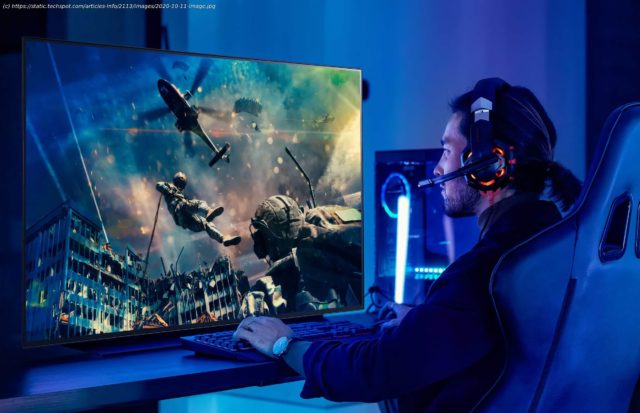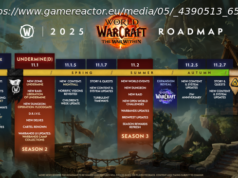With new Nvidia RTX 30 series GPUs having just launched and AMD counterparts arriving soon, it’s a good time to go through the best gaming monitors that…
With new Nvidia RTX 30 series GPUs having just launched and AMD counterparts arriving soon, it’s a good time to go through the best gaming monitors that complement the performance on offer from next-generation cards. Clearly this means focusing on the premium segment, with high resolution and high refresh rate displays. We’ll be using the RTX 3080 as our reference performance target along this buying guide. If you’re thinking of upgrading to fast GPU this generation, these are some of the best monitors that will allow you to take full advantage of all that graphics power, while also leaving some headroom for future upgrades. As a side note, you will find some of these top picks to offer good value, but if you’re playing games and want great value and decent performance, you can also check out our Best Budget Gaming Monitors guide. Samsung Odyssey G7 32″ Curved In numbers Price: $749 on Amazon Price History TechSpot Metascore: 86 User Reviews: 8.4 Price History If you’re buying a new high-end GPU this generation, it’s the perfect time to get a high refresh 1440p display if you haven’t made the jump yet. Particularly in the high-end market, there are a ton of great options to choose from which will be perfect for the graphics performance on offer this year and into the future. At 1440p there’s really two ways you can go. If you’re after something decent but don’t want to blow the bank, today’s high-end 1440p 144Hz monitors are a great choice (see our recommendations below). But if you want the best of the best to really squeeze every last drop out of something like the RTX 3080, then we’d be leaning towards 1440p 240Hz which has hit the market in a big way. A GPU like the RTX 3080 and especially the RTX 3090 can often push frame rates above 144 FPS at 1440p. Games like Death Stranding, F1 2020, and Doom Eternal, plus the usual suite of esports titles like Rainbow Six Siege. To many, the refresh rate difference between 144Hz and 240Hz is going to be small, but after a few weeks using a 240Hz display you’ll notice the improved responsiveness and motion clarity. But there’s more to buying 240Hz than just the refresh rate: 240Hz displays also usually come with better response times at both 240Hz and lower refreshes, which leads to less blur, making them better even while gaming at 144Hz or thereabouts.240Hz is also more future proof; this sort of 1440p display is perfect for not just an RTX 3080 today, but also the next few generations of GPUs. With that said, there aren’t a ton of 1440p 240Hz options on the market right now. The best that we’ve tested so far is the Samsung Odyssey G7, available in both 32 and 27-inch sizes. At $700 to $800 depending on which model you choose, the G7 is quite a bit better than the 144Hz options we’ll discuss in a bit, so let’s work through the benefits. Response times are faster: the Odyssey G7 offers a 3ms grey to grey experience, which is about 25% better than 144Hz options. This is combined with that higher refresh rate, and excellent performance across the refresh range, to deliver a stunning gaming experience. It’s also a VA panel, meaning we’re getting a superior contrast ratio and with Samsung’s tuning, no dark level smearing. Many of the same color benefits are present, like a wide color gamut and even limited semi-HDR functionality. While we love what the G7 offers in terms of response times and refresh, there are some weaknesses as well. We’re not big fans of the 1000R curvature, which is very curved, although your take on that may vary. Our review unit also had some issues with uniformity, and while we didn’t experience flickering problems, other buyers have reported such issues. If the Odyssey G7 doesn’t take your fancy, then we’d suggest waiting for upcoming models to hit the market in the next few months. There’s the Acer XV272UX, one option that will bring 1440p and 240Hz together in an IPS monitor, along with the Eve Spectrum QHD 240Hz. We’re also set to finally get 32-inch 1440p high-refresh IPS monitors later this year, such as the Asus ROG Swift PG329Q with its 175Hz refresh rate. That’s something to keep an eye out for as this monitor size hasn’t been blessed with the best high end options over the last few years, Samsung Odyssey aside. Back to top ▵ LG 27GL850 27″ Ultragear Nano IPS In numbers Price: $489 on Amazon Price History TechSpot Metascore: 83 User Reviews: 9.4 Price History While the LG 27GL850 launched last year, it’s still one of our favorite choices for this resolution and refresh rate (read our full review). You get excellent 4ms response times at 144Hz with strong performance throughout the refresh range, so even if you’re more in the 100 FPS range, the 27GL850 delivers limited blur or overshoot with adaptive sync enabled. This is coupled with great color quality, including 95% P3 coverage, excellent viewing angles and a nice flat panel. The major downside here is the contrast ratio, which is just average and won’t excite those that like to play games in dark environments. If you’re buying an RTX 3080, you can expect to hit pretty close to 144 FPS consistently in today’s games using Ultra settings at 1440p. You might not get all the way there in titles like Horizon Zero Dawn, but 144Hz is a great buy for the now. And if you’re looking to spend $400 to $500 which is where most of the best 1440p 144Hz monitors sit, here’s what we’d be looking at. The LG 27GL850 will typically set you back $500, but there’s a few other options with similar performance if you don’t want to spend that much, or have other features in mind. The LG 27GL83A for example, offers similar response times to the 27GL850, but cuts out wide gamut support in favor of just sRGB coverage. That’s still going to give you a great experience for gaming, but you’ll shave off at least $100 to the price tag. We’d also be on the lookout for the LG 27GN850, which is a 2020 refresh of the GL850 and might be a better deal in your region. Another option that’s gathered a lot of interest is the Dell S2721DGF. We’ve yet to test it, but it uses the same panel as the 27GL850, so by all reports it performs roughly the same. One reason to get this over the 27GL850 might be its slightly higher refresh rate of 165Hz, which is offered at the same $500 price point. If you want a high-end 1440p monitor, you’ll probably be looking at something that uses IPS LCD technology as it provides the best balance of decent response times, great color performance, excellent viewing angles, decent uniformity and a selection of mostly flat panels. When you have tech that ticks all those boxes, it’s bound to be the high-end option that commands a price premium, however high-quality 1440p high-refresh IPS monitors have come down in price substantially in the last two years.






